Bayern Munich has had a rollercoaster of a season by their standards, dropping 12 of their first 30 points possible. While their lowest position in the table has only been 7th, earning 18 out of a possible 30 points was not considered to be good enough for the Bavarian giants. Niko Kovač was relieved of his managerial duties, and Hansi Flick was initially brought in on an interim basis before recently signing on to manage Bayern until 2023. One of the big moves that Flick has made which has coincided with Bayern’s ascent up the Bundesliga table is his use of Joshua Kimmich as a defensive midfielder. Under Kovač, Kimmich split time fairly evenly, spending nine of his matches at right-back and seven of his matches as a defensive midfielder. During that time period, Bayern recorded nine wins, five losses, and two ties. Since then, Kimmich has primarily served as a defensive midfielder, primarily by himself in a 4-3-3 or with a partner in a 4-2-3-1. Bayern have played 21 games under Flick, winning 18 of them, almost all of those wins coming with Kimmich playing a more central role.
This tactical analysis serves as a scout report for Joshua Kimmich. An analysis of the tactics used by Hansi Flick will provide an explanation as to how Kimmich fits into Bayern’s plans, and how he has contributed to their climb back to the top of the Bundesliga, where they currently sit at the top of the table with 55 points, four points ahead of their rivals Borussia Dortmund.
Defensive positioning & responsibilities
One of the main priorities for any defensive midfielder is to make sure that he is providing cover for the defensive line behind him. The more work that Kimmich can do to protect them means that those four, particularly the two centre-backs, are less likely to be forced into making a challenging decision. With much of the time in his career spent as a right-back, Kimmich likely has a deep understanding and appreciation for the role a successful defensive midfielder plays. His ability to constantly scan the field in all phases of the game make him one of the top defensive midfielders in today’s game.
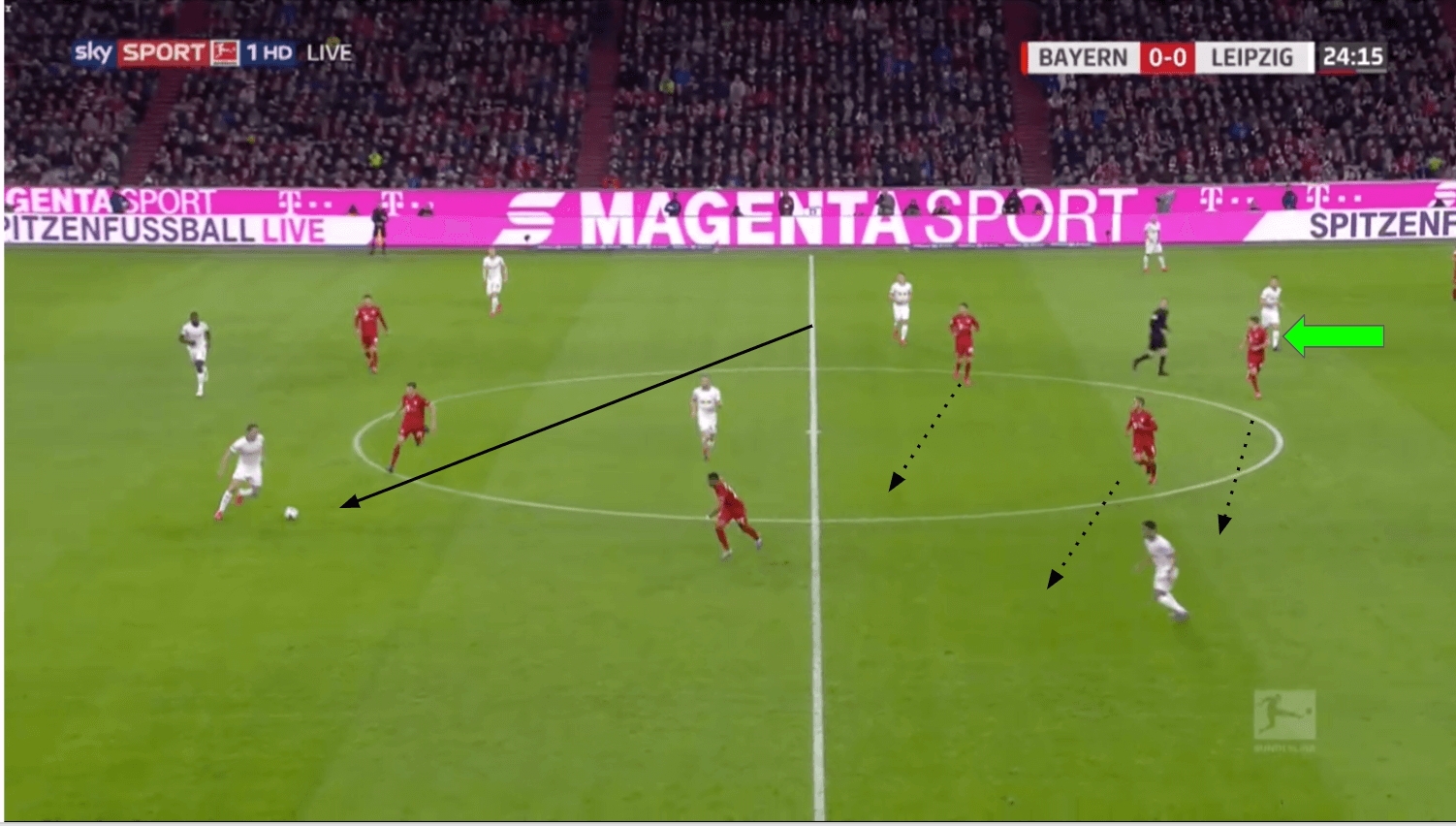
In this image from the match against RB Leipzig, Bayern had just been defending on the right side of the pitch, where the pass is played from. As Bayern’s players began to shift over to defend, Kimmich, highlighted with the green arrow, continued to check his shoulder for Dani Olmo and Timo Werner, who were running between the defensive lines all night. This continual awareness that he demonstrated allowed him to position himself so that they were not viable passing options for the man on the ball while he simultaneously occupied the centre of the pitch. This positioning, combined with Bayern’s pressure from its other midfielders, allowed them to quickly regain possession and attack Leipzig.
While the occupation of space as a midfielder is incredibly important, Kimmich is also able to pressure opponents in order to provide cover for his backline, allowing for them to maintain their shape and become more difficult to score on. Because he is incredibly fast and agile, Kimmich can redirect quicker than most.
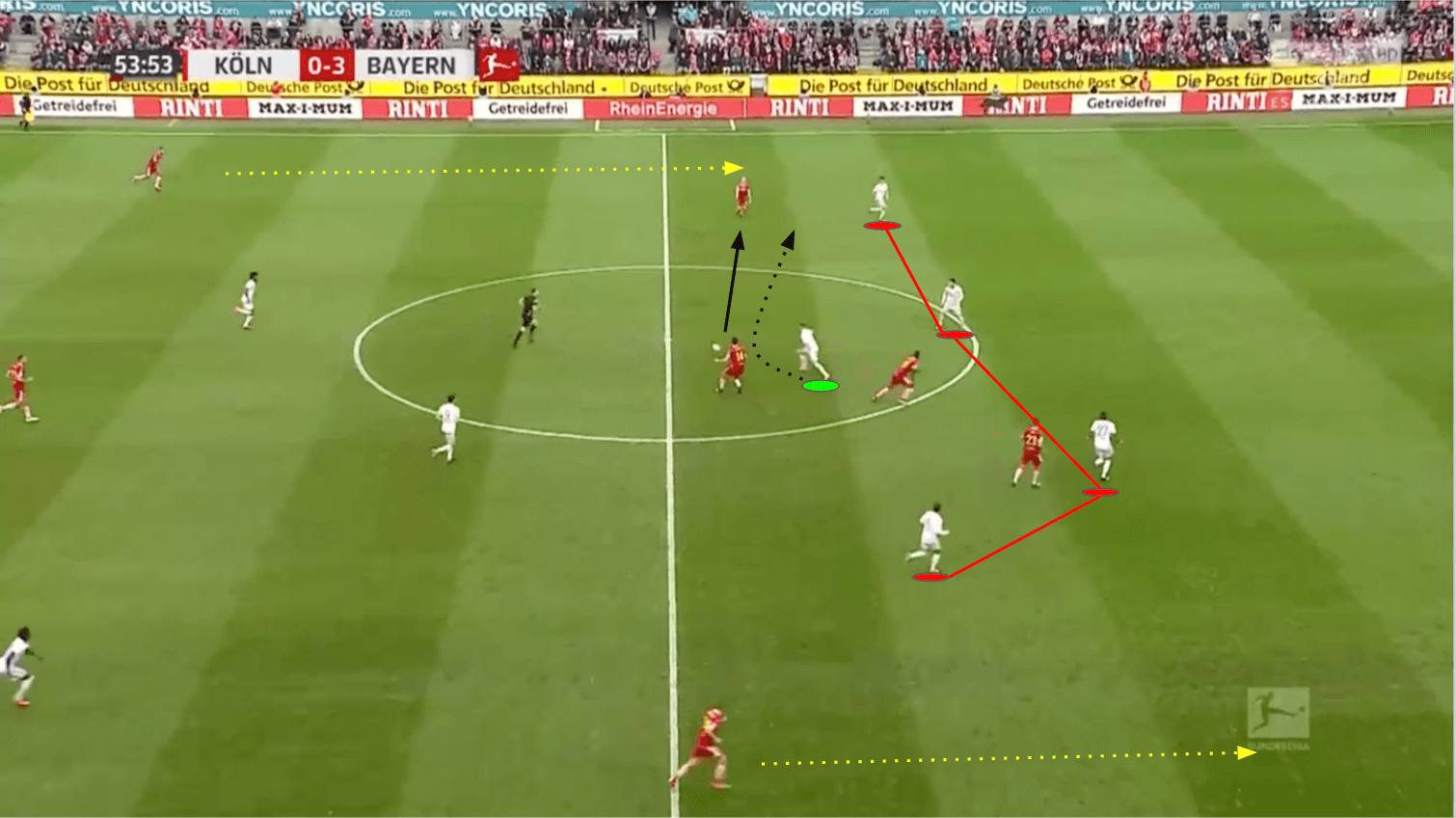
Here, against 1. FC Köln, Kimmich, highlighted in green, was defending in front of the back four. The centre-backs, David Alaba and Lucas Hernandez, were already occupied by two of Köln’s attackers. As Köln’s wingers bombed forward, Kimmich recognised that his right-back, Benjamin Pavard, was about to be put under a 2v1 numerical disadvantage. Kimmich quickly sprints over to the right side of the pitch, forcing the man on the ball towards the touchline with his body shape. As the Köln winger arrived, Pavard and Kimmich were now in a qualitative advantage in their 2v2 scenario, and Pavard quickly cut out the attempted through-ball. While Kimmich is able to provide cover and protect his backline, he also plays a key role in Bayern Munich’s build-up.
Role in Bayern’s build-up
One of the main ways that Kimmich contributes to Bayern Munich’s build-up is by dropping between Bayern Munich’s centre-backs. This temporary back three can help control the midfield and solidify build-up play. One way it does this is with the positioning of the three players. By spreading out across the centre of the pitch, it allows them a greater range of passing options, with more angles and opportunity for them to progress the ball forward. Instead of having one or two passing options that a centre-back pairing would have, the three players have two or three options. This makes their play less predictable, creating an advantage for Bayern.
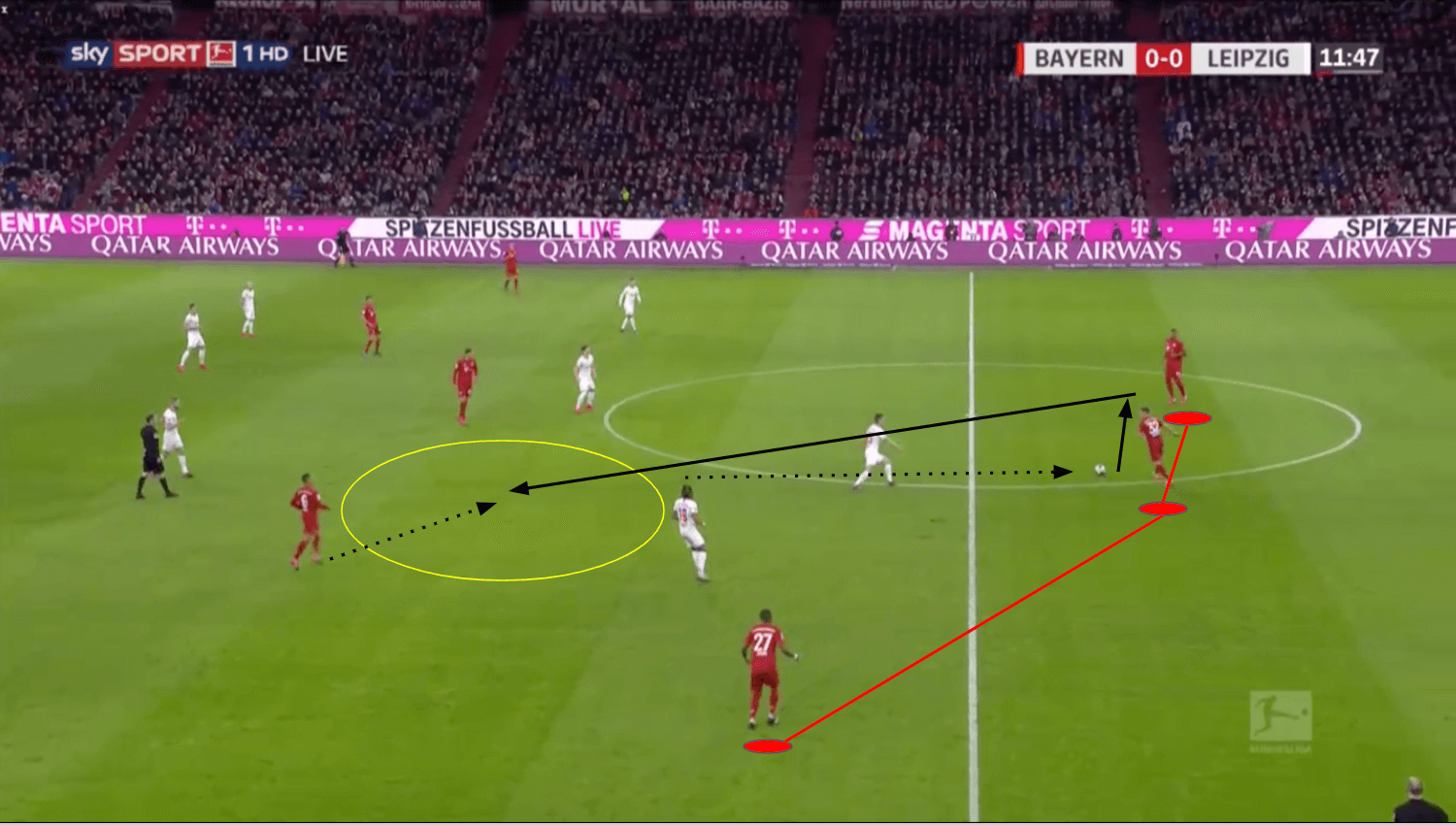
In the image above, Kimmich dropped between David Alaba and Jérôme Boateng, creating the temporary back three. As he created the back three, he also created space in the area that he had just left, as his defender followed him and pressured him. As Kimmich drew the pressure, he laid the ball off to Boateng, who was able to play Thiago, who had just occupied the space that Kimmich left. While this initial movement didn’t allow Bayern to play through, Kimmich and Thiago continued (all match) to rotate and progress through Leipzig’s first line of defence.
Kimmich also collaborates with Thiago to create space for Thiago to receive a pass by driving into a space where the final ball will end up. This signals to Thiago where he’ll need to go; he simply needs to time his run appropriately.
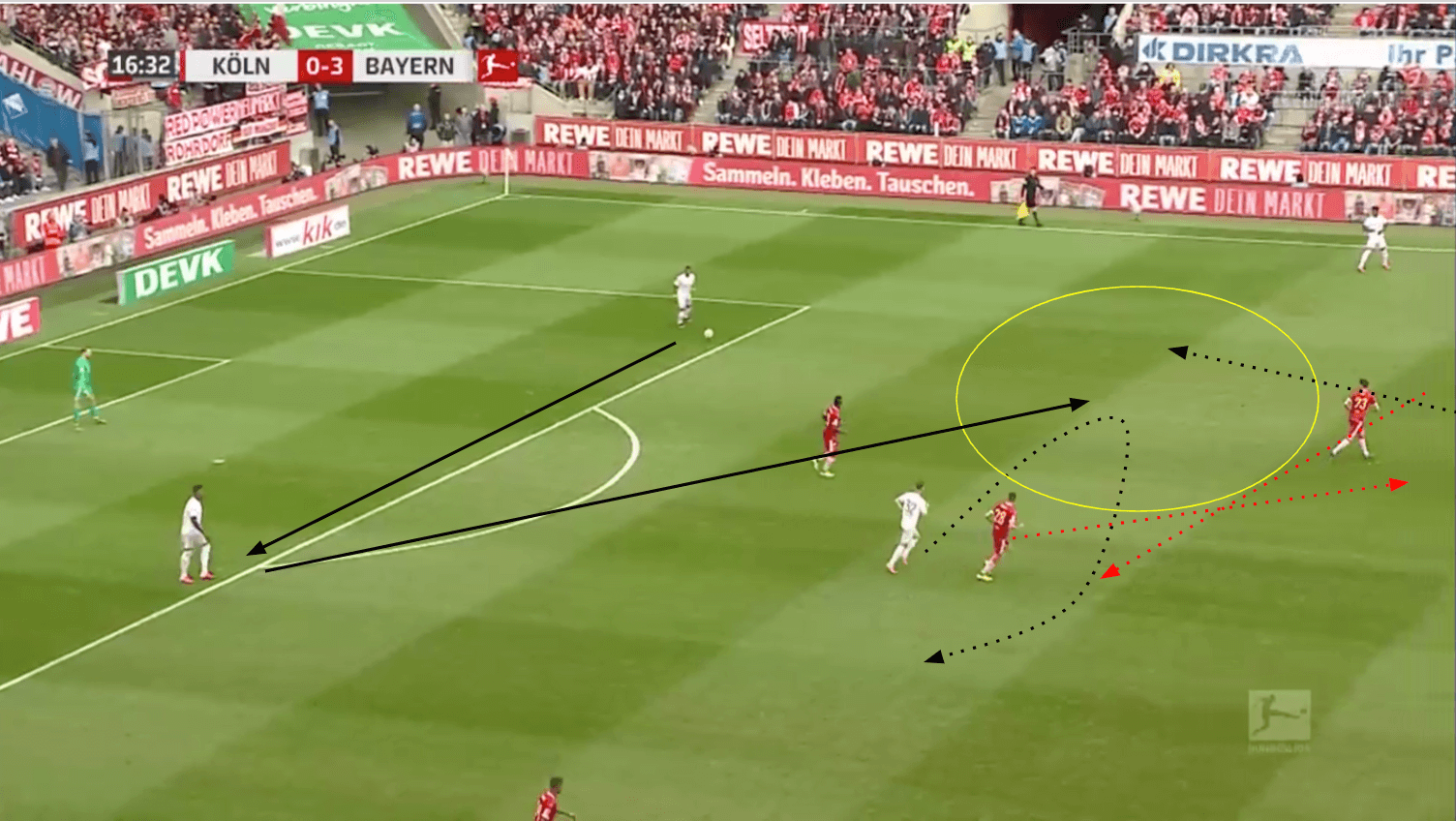
Here, Kimmich’s movement towards the ball-side began as Alaba was in possession. Alaba switched the ball to Boateng, prompting Kimmich to return towards the ball. In this case, Kimmich checked back towards the ball higher up the pitch than his previous location. The defenders actually switched off, so Kimmich had a new man marking him as he made his run back to Boateng. Because his run was higher up the pitch, there was more room for Boateng to play his pass into the space that Kimmich had just left. This, coupled with the defenders switching who they were marking, allowed Thiago to receive the pass with more time and space available to him.
Transitioning from attack to defence
Another key part when looking at a player’s contributions, especially when looking at midfielders, is his role in transitions. While he certainly can contribute to Bayern Munich’s counterattacks, part of what makes Kimmich such a valuable contributor to this Bayern team is his role in preventing opponents’ counterattacks. His ability to shut down opponents’ transitions from defence to attack come from his pace and his ability to read the game.
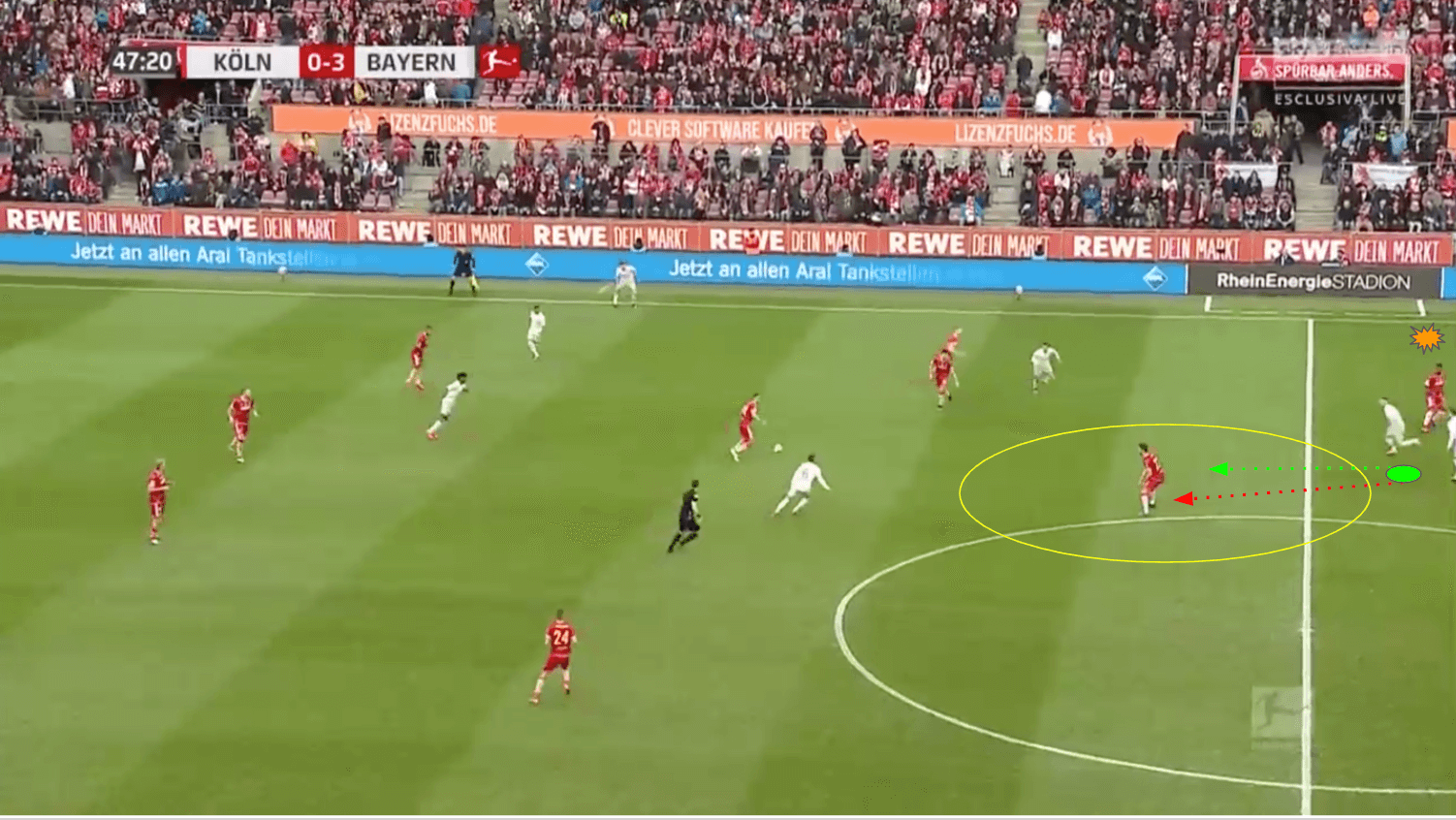
The first example comes from Bayern’s match against Köln. Bayern had just ceded possession and were probably at their most vulnerable organizationally, as they had not yet found their defensive shape. Additionally, Bayern gave up the ball in the centre of the pitch, which becomes incredibly dangerous for an attacker because one well-placed pass can split open a defence. Most defenders and midfielders would see an attacker in all that space, and they would follow the option of the red arrow, which would allow them to be in an excellent position to stop any attacker from turning and playing a pass.
However, Kimmich didn’t choose that path; instead, he opted for the path of the green arrow, which accomplished two things. While those may seem incredibly similar (and they are), his choice is what makes him such a valued member of Bayern’s squad. Firstly, it still made it incredibly difficult for the attacker to turn with the ball, as Kimmich could easily slide over and defend properly. Secondly, he was also preventing a through ball to the attacker marked with orange. This counterattack was effectively shut down because of Kimmich’s ability to eliminate two attacking options with his positioning, which allowed Bayern to win the ball back seconds after they originally lost possession.
Again, against RB Leipzig, Kimmich’s movement and positioning allows Bayern to win the ball back quickly after losing possession. This time, it occurs much closer to the opponents’ goal.
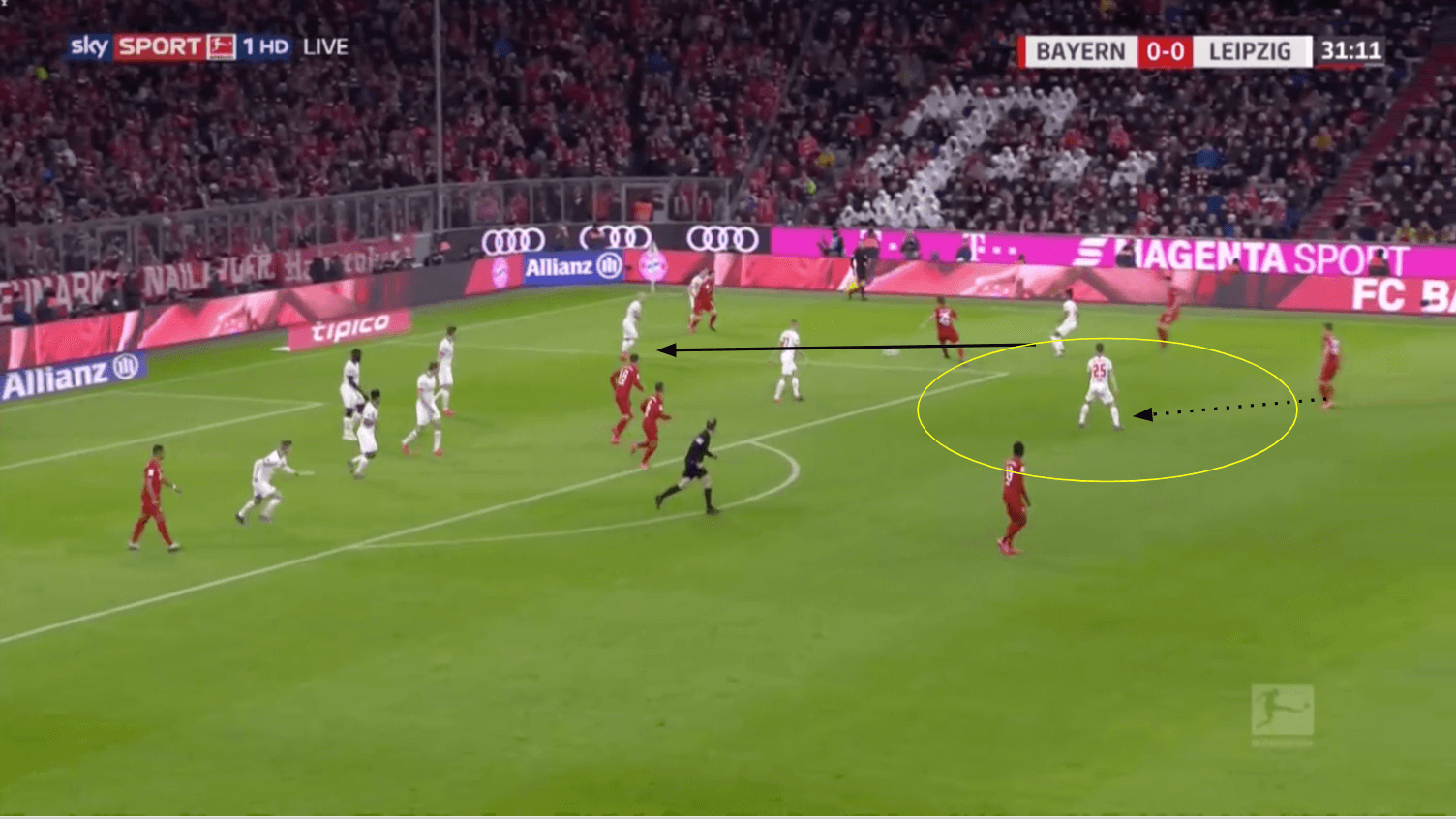
Christopher Nkunku was attempting to play Angeliño a pass in order for Leipzig to escape Bayern’s counter-pressing. As the ball went back to Angeliño, the majority of the players on both teams stepped up the pitch in anticipation of a pass being sent up field. Here, the most dangerous option is Dani Olmo, who is wearing number 25 and open in all that space. As most players stepped away from the ball, Kimmich stepped up into the pressure. This intelligent decision allowed him to get in front of Olmo and eliminate him from the play entirely. This caused Angeliño to take another touch with his dribble, which allowed Leon Goretzka to step in and apply pressure on Angeliño. Kimmich’s positioning and quick-thinking had once again put Bayern in an advantageous position.
Manipulation of defenders to create space
A large way in which Kimmich contributes further up the pitch is through his ability to manipulate defenders in order to create space for his teammates. This goes beyond the rotations mentioned earlier because it involves him in possession as opposed to him just making intelligent runs. Both examples come from the match against Leipzig. The first came in the 19th minute as Bayern were recycling possession.
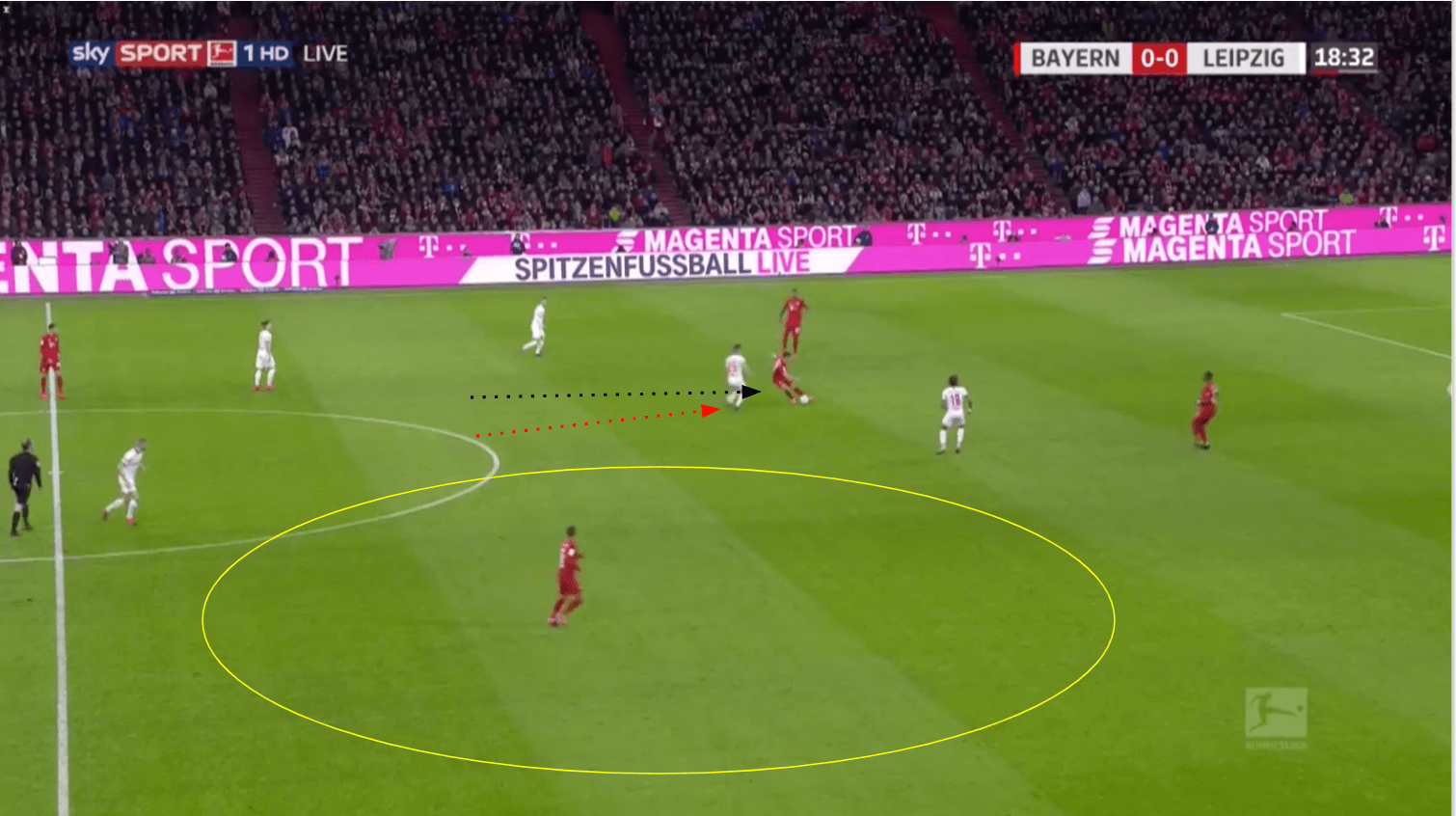
Neuer had just played the ball to Alaba when Kimmich began to check to Alaba. In the two seconds that Kimmich was checking to the ball, he checked the space over his right shoulder a total of three times. What he saw was that Olmo was following his run, which left Thiago open in all that space. Kimmich continued to disguise his plan to play the ball forward by not turning his hips until it arrived at his feet. In the image, Kimmich is holding what looks to be an uncomfortable position because his hips were facing his own goal when he began to make the pass. If he were to have opened his hips up towards the goal he was attacking, Leipzig players would have read that and pressed his teammates. Instead, what appeared to be an innocuous run back to the ball resulted in a pass that eliminated three Leipzig players from their defensive responsibilities.
The next example involved a simple wall pass that created space for Boateng to deliver a vertical pass.
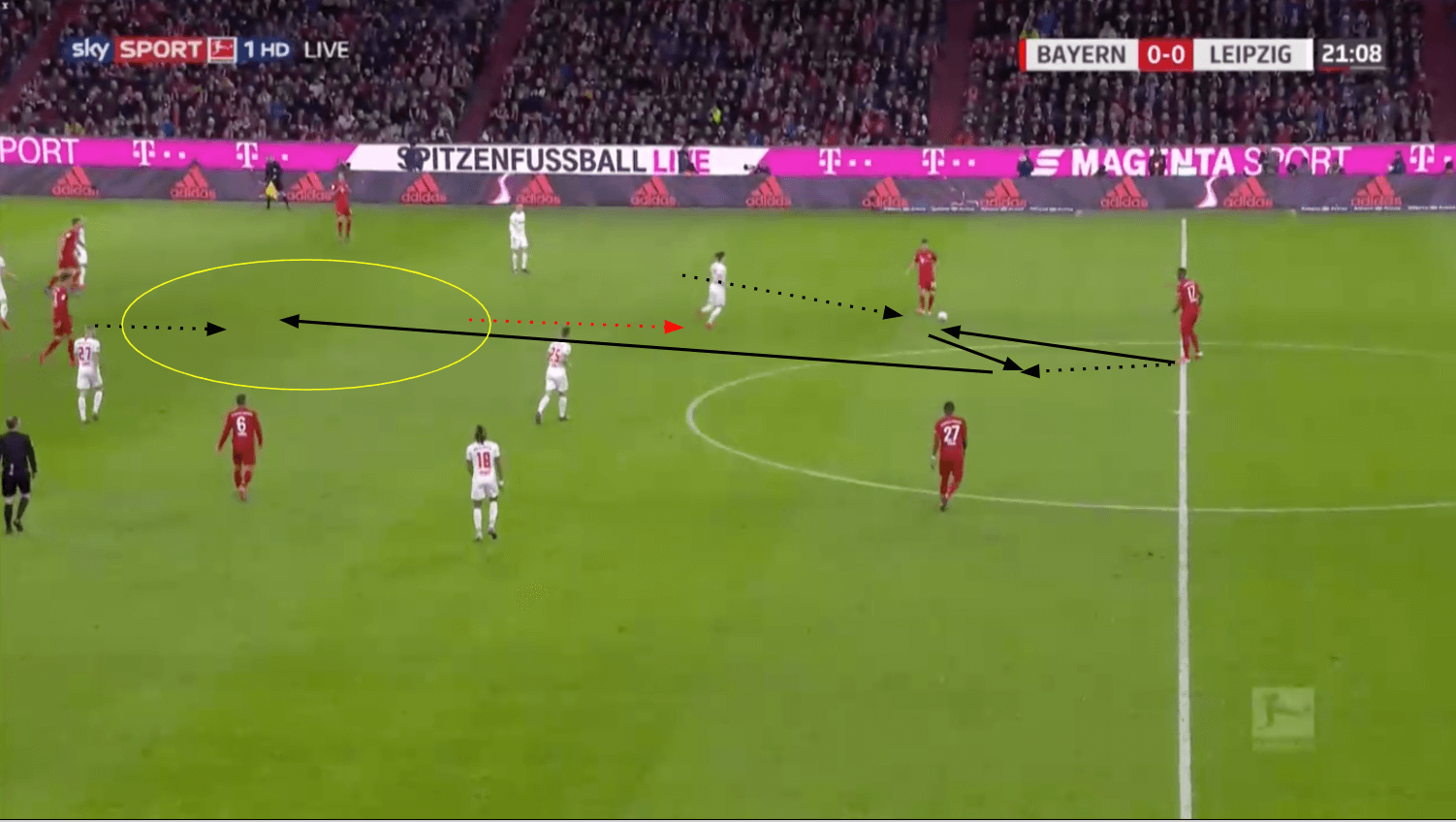
Kimmich checked to the ball as Boateng received a pass from Alaba. As Boateng went to play Kimmich, Marcel Sabitzer, the RB Leipzig midfielder, pressed Kimmich, whose first touch went back to Boateng. This simple wall pass was used to move Sabitzer out of the space he was occupying. Boateng took one touch and played a firm pass to Goretzka, who was checking into the space Sabitzer was vacating. Goretzka was able to turn and play a diagonal pass down the wing, and all of a sudden, Bayern Munich were able to play through two lines of Leipzig’s defence. This simple yet effective move by Kimmich demonstrates his ability to manipulate defenders when in possession, making him an integral part in Hansi Flick’s squad.
First touch out of pressure
The finishing touch on the magnificent footballer that is Joshua Kimmich has to be his ability to utilise his first touch to get out of pressure. This ability stems from him being able to accurately read his opponents, teammates, the ball, and space in an incredibly small amount of time. It also stems from years on the training pitch spent honing his first touch. The first example comes when Bayern are under immense pressure in the centre of the pitch.
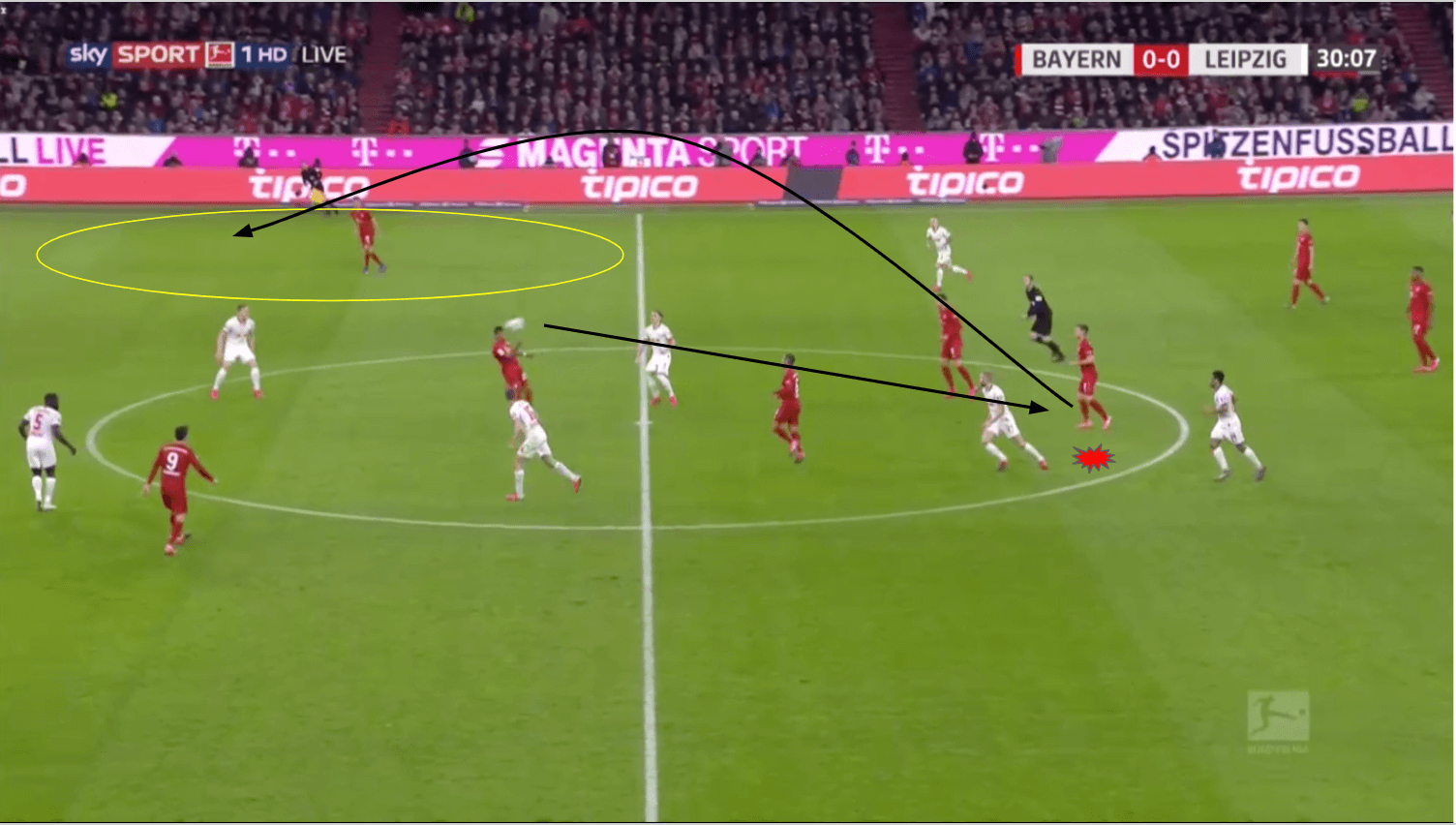
Kimmich was about to receive the headed pass from Serge Gnabry. Around him in the centre circle and its vicinity were ten other players, which, including Kimmich, counted for half of the players on the pitch in a very tight area. Kimmich quickly identified this as he was about to receive the pass, noticing Thomas Müller who was open on the right side. As the ball arrived at his feet, his first touch sent it directly to Müller, getting Bayern out of pressure and putting Leipzig under it.
Later in the match, a deft first touch got himself out of pressure while also eliminating three Leipzig players who were aggressively pressing the ball.
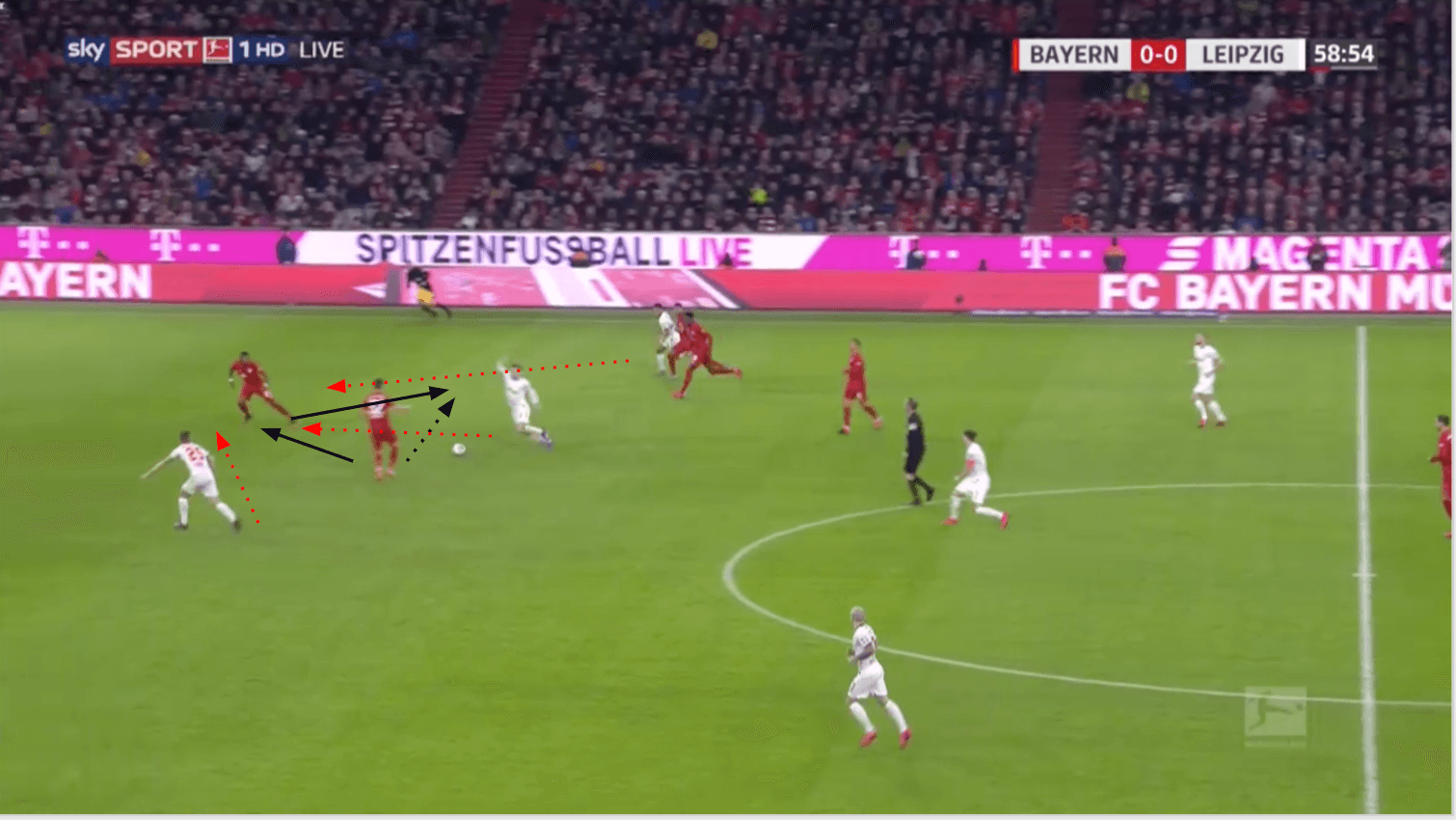
A slow-rolling ball that was followed by a pressing Leipzig player found its way to Kimmich’s feet. Instead of panicking and clearing the ball, Kimmich’s first touch laid the ball off to Alaba, getting Kimmich out of pressure, but quickly putting Alaba under it. Kimmich then took two steps forward to get into a passing lane, which allowed Alaba to play his first touch back to Kimmich. At this point, all three of the pressing players had run past their markers, and Kimmich’s first touch opened up his hips and invited another Leipzig defender forward. As Konrad Laimer stepped to pressure Kimmich, Serge Gnabry made his run up the left side, where Kimmich cooly slid him a pass that caught him mid-stride. Bayern once again were not only able to escape pressure due to Kimmich’s first touch, but they also put their opponents under immediate pressure as well.
Conclusion
It’s quite clear that Joshua Kimmich has a profound impact on the success of Bayern Munich. His ability to calmly dictate games make him one of Bayern’s most valued assets. His ability to control a match clearly made an impact on Hansi Flick, whose decision to move Kimmich to a more central role has paid off large dividends, with Bayern back at the top of the Bundesliga table, challenging for their eight consecutive title. If Flick continues to allow Kimmich to shine in his defensive midfield position, Bayern Munich will almost certainly be once again lifting the Meisterschale at the end of the season.




Comments